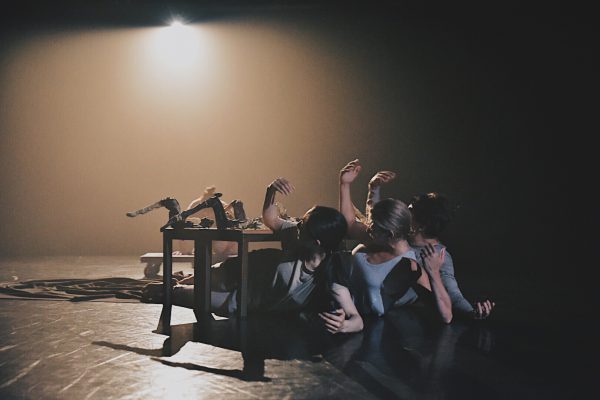For the uninitiated, contemporary dance can seem inaccessible, weird even. But the participants (neophytes, for the most part) of Alors, on crée?, a cultural mediation project initiated by Montreal choreographic centre Circuit-Est, makes it seem deceptively easy.
The underlying exercise is simple. Participants are divided into teams of two with one partner spelling out the letters of her first name using her body, while the other has to somehow incorporate her own body into the movements.
The shapes that emerge are surprisingly dance-like. And when someone risks a movement that doesn’t quite work, both teammates simply start laughing more often than not.
As easy as they make it seem, it’s probably anything but. The sessions take place in Circuit-Est’s newly opened Studio C, a large, bright space with enough windows not to require artificial lights. For non-dancers, the space can be as intimidating as it is beautiful. And the duos require such physical proximity they become almost intimate. As I watch, I’m glad I get to sit on the sidelines.
*
“There’s this white space with nothing in it, where everything is possible. It’s a writing space, a space of movement, ideas and discovery,” says choreographer Danielle Lecourtois, who acts as the project’s artistic counsellor. “There’s this space and the space between your body and the other body.”
The notions of space and bodies are crucial to dance. But the eight-week workshop is not merely a contemporary dance class. As Lecourtois explains, they don’t expect to make professional dancers out of the participants in eight weeks. Instead, it’s all about encounters and discovery — of others, of course, but also of the self and the creativity that dwells within. Contemporary dance is merely the medium used to achieve that aim. The exercise revolving around the participants’ first names becomes almost a metaphor: a dance with identity at its core, waiting to be unveiled.
“It’s a solitary journey, but also a journey we take two by two, and as an entire group at the same time. There are several layers to it,” says participant Habiba Nathoo. As a visual artist and storyteller, she joined the project to further her artistic process. To her, the journey itself is the end goal. “Each of us has a dance inside that is our own. It’s an extraordinary human experience.”
Cultural mediation is a recent development at Circuit-Est. Its primary function is making studios and other resources available to professional choreographers and dancers, but in the past couple of years, reaching out to the local community has become an increasingly important element of the organization’s mission.
“We want to bring the community and the artist together. It’s an encounter, really, because when we penetrate into someone else’s reality, it allows us to understand it better and enter a relationship of mutual support. For me, a project like this really works both ways,” says General Manager and Artistic Director Francine Gagné.
Journalist Fabienne Cabado agrees. She was at first approached to chronicle each session for the blog dedicated to the project, but she decided to live the experience for herself instead of merely observing. She is also involved in what she calls intellectual cultural mediation by hosting conferences and events, but says that this aspect of cultural mediation — sharing and creating with the public — is gaining traction.
“Now I understand why. Not only does it reveal beings to an unbelievable degree, but it really creates a bridge toward creation,” says Cabado. “And I’m sure it nourishes the artists too. It’s a way to be involved in the community, which is really important, and it can have as big an impact as a masterpiece onstage.”
Last year, when Circuit-Est launched its first large-scale cultural mediation project — called Alors, on danse? — it introduced contemporary dance to visually impaired people under the guidance of choreographer Catherine Tardif and composer Michel F. Côté. Following the project’s success, Circuit-Est wanted to recreate a similar experience, this time with local women.
The timing has been almost serendipitous. One of Circuit-Est’s founding members, choreographer Louise Bédard, made it known that she was interested in eventually conducting a workshop. Bédard, whose creative process is intrinsically linked to women’s issues, and who will soon be working on a duo herself, helped further define the project: create dance duos with female adults and teenagers from Montreal’s Ville-Marie borough.
Lecourtois and cultural mediator Sophie Corriveau joined the team to support Bédard in this endeavour. The trio’s task consists of introducing the participants to basic notions and ideas so that they get in touch with their creativity and learn to play with it. The direction and content of each duo’s creation is entirely up to them. These will be performed on April 26 as part of the event Québec Danse—but as Gagné stresses, “the point isn’t to put on a big show at the end.”
But for any of this to take place, people had to get onboard. Thus Circuit-Est coordinator Dominique Bouchard had to reach out to potential participants. This led to partnerships with local organizations such as the Centre d’éducation et d’action des femmes de Montréal (CÉAF) and Projet T.R.I.P., a drug abuse prevention center. While adult women were more responsive to the idea, teenagers proved harder to reach. Armed with videos of Bédard’s choreographies, Bouchard visited a number of schools, youth centres and reading clubs to recruit teenagers. “Up to the last minute I wasn’t sure we would ever find those teens,” laughs Bouchard. “It was a close call, but now we have a great group.”
And although the project was initially meant to focus on intercultural encounters, recruiting recent immigrants was also a challenge. But Bouchard’s work paid off, and the two groups consist of eighteen adult women (including a few recent immigrants) and nine teenagers. “Instead of being purely intercultural, this project can be defined as an encounter between women of all horizons. We have a wide array of women in all their diversity,” says Bouchard.
To Lise Labranche, one of the participants, this diversity is one of the salient points of the project. “This encounter between all these women is what moves me the most. Women of all ages, all cultures, all colours. I think about it all week long and I’m like a little girl, I just want Monday morning to come around already,” she says, laughing.
Labranche worked — and danced! — for twenty-five years with very young children, but despite her passion, she was recently forced to retire due to chronic pain. “Moving helps me deal with the pain. I can work with it when I’m dancing,” she explains. That’s what made her join the project. “As soon as I enter this white room with all the light coming in, it’s like the pain becomes diffuse.”
Like most learning experiences, it works by taking people far outside their comfort zone. The teenage participants are especially prone to the fear of being judged, so it is essential to create a safe space where they can feel confident enough to try out things, requiring a lot of compassion, patience and energy.
But even adults are not above doubting themselves. “Just being watched when you’re in the middle of the studio brings up issues of self-confidence and narcissism,” says Cabado. “But the best remedy to fear is action.”
“Perhaps that’s where the duo can become a form of support, where opening up to the other person can become a crutch of sorts,” muses Nathoo. “You give a bit of your weight, but you keep some of it to stay grounded.”
The public presentation of the duos will take place as part of the event Québec Danse on Saturday, April 26 at 2 pm at Circuit-Est’s Jeanne-Renaud Studio, located at 2022 Sherbrooke Street East in Montréal.





